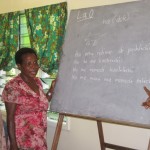By Martha Wade
“That sounds like a rap song. You were just talking. You weren’t singing,” said Gregory. I was sort of shocked by his analysis of my singing especially since I was using a simple tune that we sang hundreds of time in the car when I was a child in the 1960’s – hardly a time when rap music was around. So, I decided that that American tune would not transfer cross-culturally to this group of Elementary Prep teachers. I then asked what tune we should use and they said, “The Five Little Piggies tune” – a tune that is obviously used in all schools in the area. As I think about their critique of my singing, I am still chuckling at being identified as a “rap” music person!
Later in the week, I asked all of the groups to look at their translation of the book “Looking for Legs” – a math counting book that talks about how many “legs” various creatures have. The pictures start with snakes, which have no legs, and finish with millipedes, which have lots of legs. It is a fun book that children enjoy, but there was one problem. I had them look at the rat picture and asked them, “How many legs does a rat have and they all said, “Two legs.” Then they all looked at their translations and all had followed the English/Tok Pisin in which the rats had 4  legs. In PNG cultures, however, rats have two legs and two hands. Then we checked the other creatures. Ants and spiders had hands and legs in all 4 languages. Centipedes had either hands only or legs only depending on the language. Millipedes showed even more variety. Two languages had all legs, one had all hands, and one both hands and legs. In addition to this issue of hands and legs, when all 4 languages talked about hands and legs, they talked about legs and hands – legs always are mentioned first. After that discussion, each group revised their book. While they were revising, I assured them that it was Ok for them to use their cultural way of counting legs and hands. God loves variety and that variety was very obvious in this simple book.
legs. In PNG cultures, however, rats have two legs and two hands. Then we checked the other creatures. Ants and spiders had hands and legs in all 4 languages. Centipedes had either hands only or legs only depending on the language. Millipedes showed even more variety. Two languages had all legs, one had all hands, and one both hands and legs. In addition to this issue of hands and legs, when all 4 languages talked about hands and legs, they talked about legs and hands – legs always are mentioned first. After that discussion, each group revised their book. While they were revising, I assured them that it was Ok for them to use their cultural way of counting legs and hands. God loves variety and that variety was very obvious in this simple book.
Three weeks in July were filled to overflowing with games, songs, finger plays and helping the teachers to try to read and follow instructions in the new Elementary Prep curriculum. Time after time I was reminded of the fact that they come from oral cultures in which they need to see and do things in order to learn. Thankfully, the teachers all enjoyed role plays and some of them were quite ornery students, especially when the teacher threw in an English word that the children wouldn’t have known. My favorite was, “Teacher, what is ‘sep’? Are you talking about a man shaving?” The teacher said, “No. A ‘sep’ [shape] is something like a circle or a square or a triangle (more words that children wouldn’t know).”
Martha is a Bible translator serving the Apal language group.